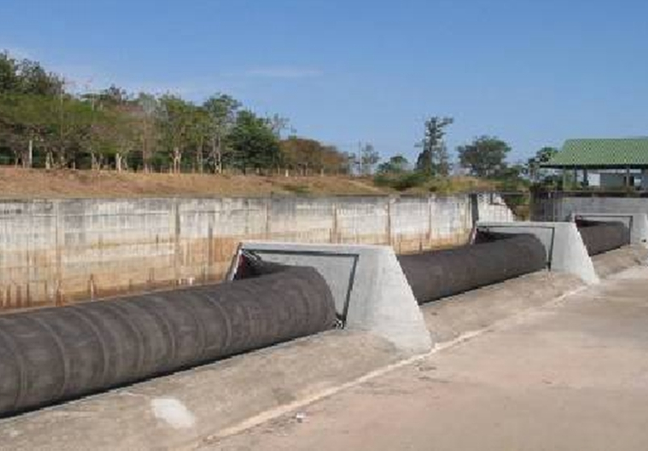

Effective flood control solutions should be affordable, adaptable, and tailored to the specific needs of a community and its flood risk profile. As climate change drives more frequent and severe weather events, the importance of resilient flood management strategies continues to grow.
Traditional dams remain a cornerstone of flood control infrastructure. By storing excess water during heavy rainfall and releasing it gradually, they help mitigate downstream flooding and protect surrounding areas.
In this blog, we’ll explore a range of flood control methods—both conventional and modern—to help you better understand your options and make informed decisions that prioritize safety, sustainability, and long-term effectiveness.

Traditional flood control techniques have long played a vital role in managing water flow and protecting communities from flood damage. Below are some of the most commonly used methods:
Dams are among the most recognizable flood control structures. They store excess water during heavy rainfall and release it gradually to reduce the risk of downstream flooding. While highly effective, dam construction can significantly alter natural ecosystems and may require the relocation of local communities.
Flood walls, including seawalls, serve as solid barriers that prevent floodwaters from inundating vulnerable areas. Typically constructed from concrete or steel, they are often installed along riverbanks and coastlines. Although durable and effective, flood walls can be costly to build and may impact the visual character of the surrounding area, requiring careful integration into community landscapes.
Dredging involves removing sediment, debris, and pollutants from rivers, lakes, and other water bodies to increase channel capacity and improve drainage. While this method enhances water flow, it must be carried out responsibly to avoid disturbing aquatic ecosystems and releasing buried contaminants.
Levees are raised embankments constructed along rivers to contain high water levels and prevent overflow. They can be natural—formed by sediment buildup—or man-made using soil, sandbags, or modular barriers. Levees provide both temporary and long-term flood protection but require regular maintenance to remain effective.
Floodplains are naturally low-lying areas adjacent to rivers that absorb and disperse excess floodwater. Preserving or restoring floodplains is a sustainable approach that leverages nature’s own flood control mechanisms. However, urban development often encroaches on these areas, making zoning regulations essential to maintaining their protective function.
Modern flood sensors provide real-time monitoring of water levels, accessible remotely via computers or mobile devices. They reduce the need for manual inspections at multiple flood-prone sites, enhancing response speed. While not a complete replacement for human oversight, these sensors are valuable tools for early detection and ongoing monitoring.
Green infrastructure uses natural elements such as vegetation, permeable pavements, and green roofs to absorb and manage stormwater. This eco-friendly approach not only helps reduce flooding but also improves environmental quality and community aesthetics, making it an increasingly popular solution.
Portable and quick to install, fast-deployable flood barriers offer immediate protection against rising waters. Their ease of deployment and affordability make them ideal for emergency response, allowing even small teams to safeguard vulnerable areas rapidly.
Utilizing advanced forecasting models and communication networks, early warning systems provide timely alerts about imminent flood risks. These alerts enable communities to take proactive measures such as evacuations and property protection, reducing potential damage and loss.
Designing buildings and infrastructure with flood resistance in mind—through elevated foundations, waterproof materials, and efficient drainage systems—enhances community resilience by minimizing flood damage and recovery time.
| Aspect | Traditional Flood Control Methods | Modern Flood Control Methods |
|---|---|---|
| Main Approaches | Dams, levees, flood walls, dredging, floodplain protection | Flood sensors, green infrastructure, fast-deployable barriers, early warning systems, flood-resistant architecture |
| Technology Level | Structural, physical barriers relying on civil engineering | Integration of advanced sensors, automation, and smart technologies combined with natural solutions |
| Flexibility | Usually fixed structures with limited adjustability | Highly flexible, rapid response, capable of real-time adjustments and deployment |
| Environmental Impact | Can significantly affect ecosystems and local communities | Focuses on environmental protection and ecological balance using sustainable measures |
| Cost Structure | High construction and maintenance costs, long timelines | Lower equipment and maintenance costs, emphasizes cost-effectiveness and rapid response |
| Applicable Scenarios | Large-scale floods with stable or predictable water flow | Adapted to variable and diverse flood risks, especially suitable for emergency and dynamic situations |
| Maintenance & Operation | Requires extensive manual maintenance and monitoring | Relies on automated monitoring and remote control, reducing manual intervention |
| Community Impact | May cause relocation and alter natural landscapes | Balances community aesthetics and ecological functions, promoting sustainable development |
| Response Speed | Fixed structures with slower response times | Real-time monitoring and fast deployment, enabling quicker response |